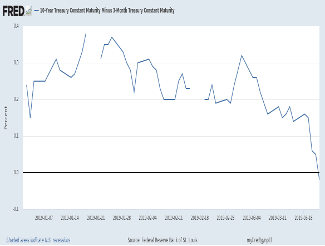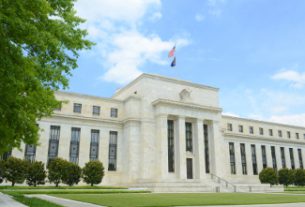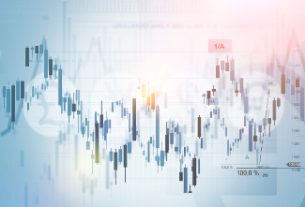Market watchers have been looking for months for signs that a recession is on the horizon. Despite all the negative economic news, from a weak housing market to falling job growth to decreased international trade, stock markets still remain at historically high levels. But now investors have the indicator they need to know that a recession is only months away: an inverted yield curve.
The yield curve is the curve that results when interest rates on various maturities of government debt are plotted on a graph. The longer the term of the security, the higher the interest rate, so the curve gently slopes upward. Except when the yield curve inverts.
An inverted yield curve means that short-term interest rates are higher than longer-term interest rates, and it’s generally seen as a sign of uncertainty about the strength of financial markets. Just about every time the yield curve has inverted, a recession has followed within a matter of months.
Normally when analysts are looking at yield curve inversions they look at the spread between 2-year and 10-year Treasury securities, or between 3-month and 10-year Treasury securities. So the fact that the yield curve started to invert late last year between the 2-year and 5-year Treasury securities, while interesting, wasn’t seen as a sign of imminent recession.
But in the aftermath of the Fed’s last monetary policy meeting the yield curve has inverted in a major way. Last Friday the 10-year Treasury yield, which had been as low as 6-7 basis points higher than the 2-year Treasury, finally inverted… but not against the 2-year. Instead, the 10-year yield fell beneath every bond with a maturity of one year or less, even the 1-month. The yield on the 10-year bond was 2.44%, versus 2.49% for the one-month bond. And that inversion continued to hold this week.
In fact, bond yields dropped so much that yields on 2-year through 7-year Treasuries ranged from 2.19-2.32% on Monday, less than the 2.41% effective federal funds rate. That’s a highly worrying sign and indicates that a recession is all but certain. Previous recessions have occurred within months of the yield curve inverting, meaning that if we’re not already in the midst of a recession, we’ll be in one by the end of this year or early next year for sure.
For investors who may have been on the fence about getting out of risky stock markets and protecting their retirement assets, the time has come for them to make a decision. Anyone still hesitant about what to do next risks losing everything by the time the depths of the next financial crisis are reached. It’s tempting to look at things with rose-colored glasses and hope for the best, but that’s not realistic.
Investors who fail to safeguard their retirement assets by, for instance, investing in gold risk setting themselves back years if they’re lucky and have a ways to go before retirement. If they’re close to retirement they could be out of luck as they see their portfolios lose half their value or more, just like in 2008 and 2009. If there were ever a strong warning sign encouraging investors to take the necessary steps to protect their hard-earned savings, the inverted yield curve is it.
Image: FRED
This article was originally posted on Goldco.




